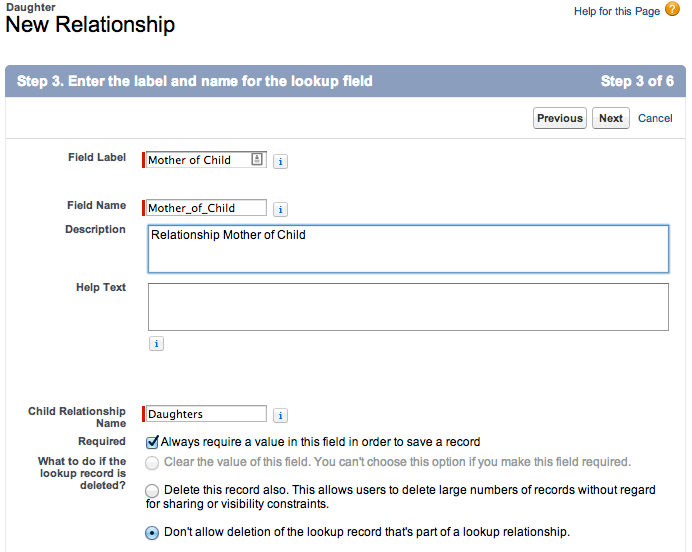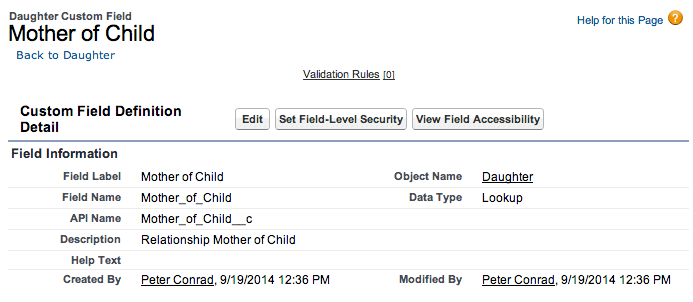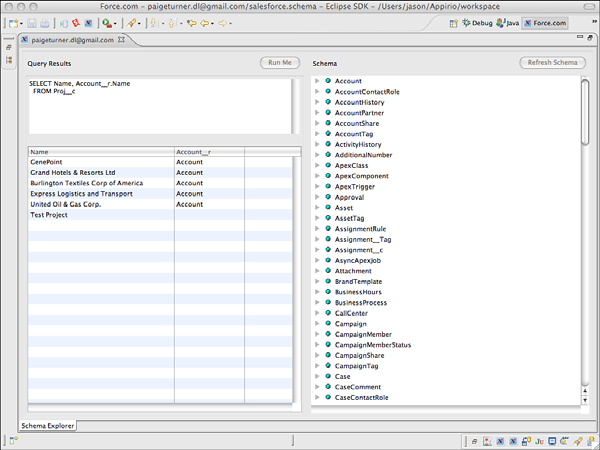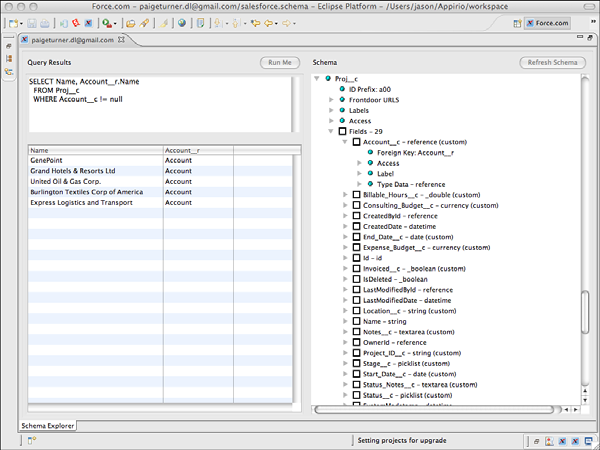End User Soql Sales User Easy Soql
Enterprises across the globe have seen a significant surge in their businesses by using the SaaS platform of Salesforce. While the CRM solution plays a significant part to ensure seamless information flow and visualization across the length and breadth of the client organization, value addition significantly relies upon the use of various data modules to extract meaningful and actionable insights. Salesforce Object Query Programming language (SOQL) is one of the key tools to query the data, to convert it into the required information.
Upon a complete walkthrough of this article, you will have a decent understanding of Salesforce along with the Salesforce Object Query Language. You will also be able to leverage SOQL Join Objects to establish joins and relationships between various objects. Read along to learn more about SQL Join Objects.
Table of Contents
- Prerequisites
- Introduction to Salesforce
- Introduction to Salesforce Object Query Language(SOQL)
- Understanding Objects
- Use Cases of SOQL
- Understanding SOQL Join Objects
- Parent Object and Child Object
- Parent to Child Query
- Child to Parent Query
- Custom Objects Relationship
- Outer and Inner Joins
- Semi Joins and Anti Joins
- Limitations of SOQL Join Objects
- Conclusion
Prerequisites
- Basic understanding of SQL.
Introduction to Salesforce

Salesform is a US-based tech firm founded in 1999, which offers innovative solutions to business enterprises in the realm of Customer Relationship Management (CRM). It primarily follows the SaaS (Software as a Service) model in the business-to-business (B2B) domain while laying its foundations on a Cloud-Based architecture. Ranging from Marketing, Analytics, Learning, Integration, Sales, and Services to employees and stakeholder management, Salesforce provides customized modules for its client enterprises to enable value addition for the latter. It not only brings efficiency to the business's processes but also helps achieve synergies by bringing people together. It plays the key role of an intermediary between businesses and relevant customer segments to deliver optimal value and enhanced user experience, thus enabling business success.
While being very comprehensive on one hand, salesforce's CRM solutions cover a wide array of industries which may include but are not limited to Retail, Manufacturing, Not-for-Profit, Higher Education, Media, Fast-moving Consumer Goods (FMCGs), and Financial Services. It can empower the organization to generate actionable insights for the consumer segment while supporting communication and visibility across the organization. Having the Cloud-based architecture, Salesforce can offer complete mobility, thus establishing an easier access and communication ecosystem to support business operations.
For further information on Salesforce, click here to check out their official website.
Introduction to Salesforce Object Query Language(SOQL)

Salesforce Object Query Language (SOQL) is an Application Programming Interface (API) used to search partner organization's Salesforce data. It is primarily used when enterprises have built a custom User Interface (UI) for Salesforce while using different modules (data is recorded and then arranged by Salesforce). While SOQL is case insensitive, it is very easy to use to write queries for fetching the data when required. It can retrieve data from a single object or multiple objects that are related to one another. Not only can it traverse the data from number, date, or checkbox fields but also sort results as part of the query.
One can query the data from Salesforce using SOQL in Apex code, Developer's Console, Salesforce REST and SOAP APIs, and Salesforce's CLI. In the later section of this article you will learn about SOQL Join Objects which will ease out the process of applying queries related to joins in SOQL.
Understanding Objects
In SOQL, database tables with the provision of storing data relevant to a particular business enterprise in any given module are called Objects. Generally, there are two types of objects:
- Standard Objects: Objects which are already built-in in the Salesforce e.g., Accounts, Contacts, Cases, Users, Products and Campaigns, etc.
- Custom Objects: Objects created by the client enterprise for effective reporting, visibility, and insights. These objects form the basis of Data Sharing, Custom Fields, Relationships to other objects, Page Layouts, and Customized UI Tab.
Use Cases of SOQL
Whether to use SOQL or not depends upon various considerations, most important of which are the requirements of the users in the enterprise. Generally, SOQL is used when it is known that data is placed in specific objects. Other considerations may include:
- Extract data from either a single object or multiple objects which are associated with each other.
- Given a criterion, tally the count of records that meet its conditions and sub-conditions.
- Sort the output information as a constituent element of the query.
- Retrieve the data by traversing the date, number, or checkbox fields.
Hevo Data helps you directly transfer data from Salesforce, and 100+ data sources (including 30+ free sources) to Business Intelligence tools, Data Warehouses, or a destination of your choice in a completely hassle-free & automated manner. Hevo is fully managed and completely automates the process of not only loading data from your desired source but also enriching the data and transforming it into an analysis-ready form without having to write a single line of code. Its fault-tolerant architecture ensures that the data is handled in a secure, consistent manner with zero data loss.
Get Started with Hevo for Free
Hevo takes care of all your data preprocessing needs required to set up the integration and lets you focus on key business activities and draw a much powerful insight on how to generate more leads, retain customers, and take your business to new heights of profitability. It provides a consistent & reliable solution to manage data in real-time and always have analysis-ready data in your desired destination.
Check out some of the cool features of Hevo:
- Real-Time Data Transfer: Hevo with its strong Integration with 100+ Sources (including 30+ Free Sources), allows you to transfer data quickly & efficiently. This ensures efficient utilization of bandwidth on both ends.
- Data Transformation: It provides a simple interface to perfect, modify, and enrich the data you want to transfer.
- Secure: Hevo has a fault-tolerant architecture that ensures that the data is handled in a secure, consistent manner with zero data loss.
- Tremendous Connector Availability: Hevo houses a large variety of connectors and lets you bring in data from numerous Marketing & SaaS applications, databases, etc. such as Salesforce, Marketo, MongoDB, Oracle, Salesforce, etc. in an integrated and analysis-ready form.
- Simplicity: Using Hevo is easy and intuitive, ensuring that your data is exported in just a few clicks.
- Completely Managed Platform: Hevo is fully managed. You need not invest time and effort to maintain or monitor the infrastructure involved in executing codes.
- Live Support: The Hevo team is available round the clock to extend exceptional support to its customers through chat, email, and support calls.
Sign up here for a 14-Day Free Trial!
Understanding SOQL Join Objects
SOQL Join Objects and gives enterprises the flexibility to establish multiple relationships via joining different objects. It not only enables enhanced visibility but can generate actionable insights for the higher management to steer the organization's strategy in the right direction. SOQL Join Objects becomes particularly useful in SOQL as it reduces data redundancy and data inconsistency for the relevant databases. They can be:
- One to one
- One to many
- Many to one
- Many to many
SOQL join objects using different queries depending upon the client organizations' data structures and information requirements. To understand the joining frameworks, it's of utmost importance to understand the relationship players which exist in the SOQL universe, given as follows:
Parent Object and Child Object
Depending upon the requirements, objects in Salesforce can be categorized as Parent and Child. The object that has a greater number of data fields can be labeled as a Parent and the one with fewer fields is labeled as a Child. Essentially, the Parent object contains the data while the child object has the lookup field against which data is required. Every relationship in SOQL is given a name, e.g., Account can be considered as a Parent of contact.

The name of the relationship could vary, depending upon the direction of the queried data. Given the Child-to-Parent relationships, the title of relationship to the Parent is the name of the foreign key. Similarly, for Parent-to-Child relationships, Child relation is given the title which is exclusive to the connected Parent, and also is the plural of the Child object name.
Parent to Child Query
Sometimes, it is required to query the data by "One to Many" relationship; it is generally categorized as a Parent to Child query. Users would want to visualize or at least structure all the contacts associated with the specific accounts. "Inner Query" is used to traverse the data modules for the said joining and the general syntax is given as follows:
To extract the Contacts associated with a particular Account, the following SOQL Query can be used –
SELECT Id, Name, (Select Id, Name FROM Contacts) FROM Account WHERE Id IN:accList Child to Parent Query
Sometimes, it is required to query the data by "Many to One" relationship; it is generally categorized as a Child to Parent query. The general syntax for the said joining is given as follows:
While working with the Contacts records, one can look up through all the data and retrieve any field e.g., Account Shipping Address from a particular contact, with the SOQL query mentioned below:
SELECT Id, Name, AccountId, Account.ShippingAddress FROM Contact Custom Objects Relationship
In Salesforce, users can certainly establish relationships amongst custom objects using SOQL Join Objects – it also ensures that not only custom object names, but also the names of custom fields and the associated relationships remain unique to avoid any confusion and redundancy in traversing the databases. Whenever a new custom object is created in the UI of SQL, it demands the user to specify the plural variant of the object name, which is used in the joining queries.

Once a join is created, it is worth noticing that the associated API name is the name of the created custom field, appended by __c. Similarly, when custom objects are formed in the SOQL data visualization, the relevant API name (object name appended by __c), and same should be used to prevent any ambiguity, especially when SaaS can create a standard object with the same name as of custom object/field.

An example of the syntax for joining two custom objects is given as follows:


Outer and Inner Joins
Random joins in SOQL aren't supported but it surely provides some features to control related objects in the relevant modules of Salesforce. One of them is Inner Join: it is primarily used to join the objects (Parent and Child) to extract all the associated fields from the base objects which may include the data of non-referred related objects. For example:
SELECT NAME, ACCOUNT__r.NAME FROM PROJ__C. Here, the Name and Account name is being retrieved from the object Project, which essentially is labeled as a custom project. Here Parent object is the Account and the child object is project, while the relationship amongst the two is the Look-up relationship. The custom objects as usual are characterized by the __r keyword in SOQL.

Inners joins are utilized for the filtering of records that aren't matched with the required informative objects i.e., unmatched records can be eliminated via filtering conditions. For example:
SELECT NAME, ACCOUNT__r.NAME FROM PROJ__C WHERE ACCOUNT_c !=NULL. 
Semi Joins and Anti Joins
To enhance the usage and effectiveness of relationship queries in SOQL Join Objects, Semi-Join and Anti-Join queries can be used. They are particularly useful while dealing with Parent-to-Child and child-to-parent relationships. While utilizing the sub-query mechanisms, they allow the records to filter from one database to another. Before delving into the details of the subject joins, it's critical to realize that one can extract values related to an object in any field, even though other fields contain the records for the same subject: it is done using IN function.

More so, the level of complexity can be increased by employing the sub-query modules with IN and NOT IN. It can mesh by ID (primary key) or reference (foreign key) fields. A subquery applied on another object in an IN condition to confine the records extracted is called the Semi-Join. On the other hand, an Anti-Join is a subquery on another object in a NOT IN condition to confine the records extracted. The usage of these sub-query joins might include, but isn't limited to:
- Get all contacts for accounts that have an opportunity with a particular record type.
- Get all open opportunities for accounts that have active contracts.
- Get all open cases for contacts that are the decision-maker on an opportunity.
- Get all accounts that don't have any open opportunities.
For example, a Semi-Join can be used in a WHERE clause and as mentioned below, can extract the account IDs if the relevant opportunity is forgone in the parent to child semi-join from Account to Opportunity.

Similarly, the following Anti-Join query can return account IDs, given the condition that accounts are those which don't have any open opportunities:

Limitations of SOQL Join Objects
Like every other Query Language, SOQL Join Objects is guided by a specific set of limitations which are discussed as follows:
- The existence of a relationship between two objects is the prerequisite of using joins in SOQL.
- A query can cater up to fifty-five (55) Child-to-Parent relations. The relationship counts for a custom object are limited to forty (40). For the Parent-to-Child query, the number of viable relationships stands at twenty (20).
- In any given Child-to-Parent relationship, only five (5) levels can be traversed for data query.
- Only one (1) level can be specified for the data query in any given Parent-to-Child relationship.
- Additional data i.e., notes and attachments can be queried for the relevant information but filter can't be applied to the content on these resources.
- For external objects, any give sub-query can extract and display up to a thousand rows.
- For external objects, any given query can have up to four (4) joins. While the execution of the query is in progress, every join requires a complete traverse of the external system, which results in longer response times.
Conclusion
SOQL can enable the end-user to establish various joins across different objects (both standard and customized) to counter data redundancy and data inconsistency, thus fully capitalizing on the strength of Data Analytics. Of course, there are certain limitations associated with SOQL Join Objects as far as the use of joins is concerned, but it is a handy tool for empowering enterprises to achieve the unprecedented!
In this article, you learned about Salesforce, its key features, and how to leverage SOQL Join Objects to establish relationships between multiple objects. Integrating and analyzing your data from a diverse set of data sources can be challenging and this is where Hevo Data comes into the picture.
Visit our Website to Explore Hevo
Hevo is a No-code Data Pipeline and has awesome 100+ pre-built integrations that you can choose from. Hevo can help you integrate your data from numerous sources such as Salesforce and load it into a destination to analyze real-time data with a BI tool and create your Dashboards. It will make your life easier and make data migration hassle-free. It is user-friendly, reliable, and secure.
Want to take Hevo for a spin? Sign Up for a 14-day free trial and experience the feature-rich Hevo suite first hand. You can also have a look at the unbeatable pricing that will help you choose the right plan for your business needs.
Share your experience of learning about SOQL Join Objects. Let us know in the comments below!
Source: https://hevodata.com/learn/ultimate-guide-to-soql-join-objects/
0 Response to "End User Soql Sales User Easy Soql"
Post a Comment